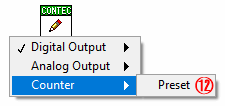





Perform digital output, analog output or counter presetting
When performing continuous output (generating), set the data to be output with this VI
|
|
|
Select to perform 1 bit digital output *1
Select to perform 1 port (8 bit) digital output *2
③ Digital Output (Multiple bit)
Select to perform multiple bits digital output together
④ Digital Output (Multiple port)
Select to perform multiple ports digital output together
Select to perform digital output generating *3
⑥ Analog Output (1ch: Voltage/Current)
Select when specify voltage/current value and analog output to 1ch for one time
⑦ Analog Output (1ch: Binary Value)
Select when specify binary value and analog output to 1ch for one time
⑧ Analog Output (Multiple ch: Voltage/Current)
Select when specify voltage/current value and analog output to multiple channels for one time
⑨ Analog Output (Multiple ch: Binary Value)
Select when specify binary value and analog output to multiple channels for one time
⑩ Analog Output (Buffer: Voltage/Current)
Select when specify voltage/current data and continuous analog output
⑪ Analog Output (Buffer: Binary Value)
Select when specify binary data and continuous analog output
Select to set (preset) the value of the counter arbitrarily
*1 Also supports digital output of analog devices and counter devices
*2 Also supports digital output of analog devices
*3 It can be set only with the following bus master type digital devices
PIO-32DM(PCI), DIO-32DM2-PE, DIO-32DM3-PE
For example, if the resolution of analog device is 12 bit, as the operation of the hardware, the voltage width of set range will be divided into 4096 (12Bit), the divided value is called binary value. Example: If the range is ±10V The binary value 0 corresponds to -10V, the binary value 2047 corresponds to about 0V, the binary value 4095 corresponds to +10V, and the voltage difference between the binary values 0 and 1 is about 0.004883V (4.883mV) The voltage value is easy to understand intuitively, but the binary value is directly used by hardware, and there is no calculation error when voltage conversion. So the value is more accurate. And, current is the same. |